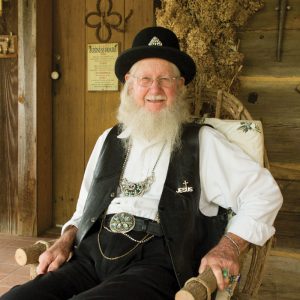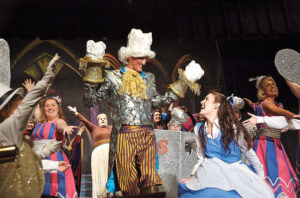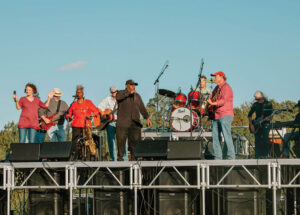
Meet Clayton Garner
 Story by Elaine Hobson Miller
Story by Elaine Hobson Miller
Photos by Wallace Bromberg Jr.
Clayton Garner sees things.
Neither ghosts nor drug-induced revelations, his visions are of projects yet-to-be constructed. His hallucinogen is creativity, and it often keeps him awake at night.
“I can see things that aren’t there,” he says. “I can see things finished before they’re started.”
A former florist, a historian and storyteller, 82-year-old Garner is a true Southern original. Some people call him, “quirky,” which in the South is just a polite term for “eccentric.” What else would you call a man who saves the cuttings from his white hair, draping them over outdoor wall decor so the fox wrens will have nest material? “I can’t stand my hair going to a landfill,” he explains.
But if Clayton Garner is eccentric, it’s because he chooses to be. He thrives on his eccentricity, wearing it as proudly as the homemade baubles and oversized turquoise necklaces that drape his neck when he goes out for Sunday dinner. He doesn’t care what people think of him. But like a larger-than-life character from a Tennessee Williams play, he does love the attention.
“I make tacky jewelry,” he readily admits. “If I’m not going to get attention, why bother?”
During his 40 years as a florist, Garner created floral arrangements for weddings and funerals. He also tore down, moved and rebuilt old houses and barns that were destined to be covered by the flood waters of a dam or eaten by vines and mildew. Now, his projects are in his own two acres of heaven in Cropwell, where he tends to his flowers and collects Garner genealogy and Avondale Mills memorabilia. He also raises purebred Nubian goats.
“I’ve been raising goats for 50 years,” he says. “I showed them at the State Fair and other shows. I’m a member of the American Dairy Goat Association.”
The man who sometimes wears a glass Jesus pin on a black vest doesn’t go to church, but has religious shrines all over his house. He believes in God and Jesus and miracles. He prays before a picture of Jesus he says turned from black and white to color overnight. He has a maple tree that was barren of buds one day, covered in its signature purple leaves the next. “I’ve learned to accept these things because I live with them,” he says.
That’s why a metal sign at the front of his yard proclaims, “Water garden plants, Miracle Acres.” Another, an historical marker, testifies that his main house was built in 1826. Confederate soldiers mustered there, and Cherokee Indians passed it during the Trail of Tears to Oklahoma territory. The house had been empty for 12 years when he got it 39 years ago. “It had three bare light bulbs, and the electricity was still on and the furniture was still in it,” he says. Built by Caleb Capps, originally it was just a one-room cabin with no windows but three doors. “In 1844, Capps sold it to John W. Jones from Virginia,” Garner says, as he begins the first of many historical recitations on an early spring tour of his property. “Jones had 10 children so he added another room and a dog trot. Several rooms have been added through the years.”
He used hired help when he first moved there in 1975, to take off the tin roof, build the porch back, to install drywall, wiring and plumbing. He put in a bath, and later tore it out and rebuilt it with marine-grade flooring and a cast-iron tub.
The chimney in wife Dean’s bedroom is original, but vines were growing from its red-clay chinking when the Garners took possession. When Garner pulled out the vines, the chinking came out. With the patience he exhibits during the hours of beading, barbed-wire bending and sewing that go into his costumes and decor, he rebuilt the chimney stone by stone, replacing mud with mortar.
His flair as a florist comes out in decor such as the barbed wire, dried okra pods and miniature wooden quail concoction hanging in Dean’s bedroom, and in the crosses of driftwood or wire and shells. Everywhere there are photographs: Of he and Dean, their daughter, their grandchildren and their ancestors. Early photos show a clean-shaven Garner with short hair, while in later ones he’s decked out in one of his costumes, or “outfits,” as he calls them, wearing a cowboy or farmer’s hat. And beads. Always the beads. They are draped over photo frames, deer antlers and crosses. They dangle from chandeliers and bed posts.
Garner points to a small, framed Christmas ornament. He made 30 just like it while recuperating from a broken leg five years ago, cutting pineapples from an antique, crocheted bedspread and sewing beads around the edges. “I’ve been doing this bead stuff a long time,” he says.
A pathway made of decorative cement tiles winds among the oxalis, English dogwoods, lenten roses, jonquils, yellow Oriental irises, bamboo, dwarf buckeye, narcissus and buttercups. Where they lead over a small stone-and-concrete bridge, Clayton tells new visitors, “Go look at those kittens and see if you can run them out from under the bridge.” He can barely contain his glee as the unsuspecting take a peak. Then he pulls a string that sets a tiny plastic-and-fake-fur troll to waving its hands and dancing from side to side. Clayton points to a spindly tree with twisted branches that stick out in every direction, like something from a surrealist painting. “This is the biggest Harry Lauder walking stick tree you’ll ever see,” he says.
In the midst of the shrubs and flowers stands a 15-foot stone bell tower Garner built a few years ago. One of its stones stands out because it’s black, charred from the fire it endured when Hall Hill School, in the former Avondale Mills village, burned down.
He doesn’t throw anything away, and sooner or later he finds a place for everything. Half-buried earthen jugs stick out of stone and mortar walls, colorful tin fish and green cactus stand silent and motionless behind a still-life “aquarium” made of boxed-in window panes, and an iron bell post flies a faded Confederate flag. It’s one of several posts someone gave him. “People give me stuff,” he says. “I don’t refuse it. I deserve it. I give away a lot, too.”
At the back of the property are two ponds, where he grows floating plants, water irises and spider lilies. “You can’t compare this place to nowhere else in this state,” he says.
Bits and pieces of St. Clair and Garner history are woven into the tapestry of the 22 rooms that make up the main house, grounds and outbuildings. The spindles in his kitchen doorway came from the Mays house that used to stand beside Cropwell Baptist Church. A chestnut bed has been in his family for 200 years. “A lot of Garners and Pearsons were born in this bed,” he says.
In 1979, he built an 8-foot-by-8-foot cabin playhouse for daughter, Michelle. The foundation stones came from his Grandfather Pence’s place on Will Creek near Attalla. Later, Clayton raised the cabin and dug out under it to build a wine cellar, which is stocked with empty bottles in a wine rack built into a wall. The rack is made from lightening rods out of Miss Iola Roberts’s house. “She was principal at Avondale Mills school,” he says. “She taught me. I was one of her pets.”
He has always salvaged old structures to make new ones. After 20 years at his own shop in Pell City and 10 with Norton’s Florist, he operated Clayton Florist for 10 more years out of a building behind his home that he refers to as “the barn house.” Framed with 2-by-6s that came from the former Tom Tucker Horse Arena in nearby Lakeside Park, it has seals of 12 x 12-foot heart pine from the old Possum Trot Church at Riverside near Huckleberry Pond. The logs in the addition to the house were salvaged from a dilapidated barn in Easonville that had to be moved to build Logan Martin Lake. Other parts came from a two-story log house on the Watson farm in Lincoln, which originally served as a post office for the Pony Express in the town of Chachotta on Choccolocco Creek. The inside walls of the barn house are lined with the last of the lumber sawed at Snead Lumber Company in Snead, Alabama.
“I have the doors to the butler’s pantry of Iola Roberts’s house, as well as its weather vanes,” Clayton says. “They are built into the barn house, too.”
The house is deceptively large, with three bedrooms, a bath, a kitchen and a hallway connecting one side to the other. Two of the rooms are upstairs, on opposites of the house. Each has its own stairway. There are photos of Marilyn Monroe and Queen Elizabeth II, because they are distant cousins, he says, and of Elvis and Larry Gatlin, because he likes Elvis and The Gatlin Brothers, a former country music group.
This is where he keeps the genealogy booklets family members have given him. He can quote the name of each person in his lineage for 47 generations, all the way back to 534. “Ten of those generations were in America,” he says. “The first cotton mill in Alabama, at Piedmont, was built by my great grandfather, William Marion Pearson of Glasgow, Scotland. He lived to be 106.” His other great grandfather, Thomas Jefferson Garner, who settled from Virginia, started the first Baptist Church in Alabama, he said.
Asked how he knows so much about history, familial and otherwise, he attempts to explain. “I’m a nut. I know a little about everything,” he says. “Trouble is I don’t ever forget. It just stacks up. If I told all I knew. …” His voice trails off, and he winks, hinting that he could get lots of folks around Pell City in trouble if he were to keep talking. “People tell their florist everything,” he says.
He has a collection of memorabilia from Avondale Mills, including signs and photos of the children who swept the floor of the mill 12 hours a day, six days a week, for the silver dollar paid to their parents weekly. An upstairs bedroom displays several manually-operated office machines from the mill. “My mother worked there,” he says. “I went to school there. I knew everyone in the mill houses. They’re all gone now, the houses and the people.”
Two hexagon-shaped, colored-glass windows in an upstairs parlor inspired him to build an addition to the barn house. “The windows came from an old cathedral in New Orleans, and they change colors as the light of the day changes,” Garner says. “The colors were sprayed on them. It’s a lost art.”
He built the 19-foot rock-and-cement chimney that is connected to an old Imperial Beaver wood-burning stove that he used to cook on. Now, the stove’s oven and warming box hold more of his beaded trinkets.
Some of his trinkets and costumes are seasonal, like the cape he made from a Christmas tree skirt and a fox-fur collar he found at a local thrift shop. When he wears one of his outfits, he accompanies it with a shiny, twisted, wooden walking stick, again draped with his signature beads. He also carries a tiny flask that he dramatically lifts to his lips from time to time, although it’s always empty. “I don’t dress like this all the time,” he confesses. “Only when I’m on stage.” One of his stages is the Cracker Barrel in Pell City, where he has lunch every Sunday. “I walk among the tables so everyone can see me,” he says. “The people love it.”
He says he can’t take credit for all of the decor in his buildings, though. “Dean crocheted the coverlets on five of the beds in our house and the barn house,” he points out. “She made most of the curtains, including the set that she made from striped overalls denim made at Avondale Mills here in Pell City.”
Come July, he and Dean will celebrate their 47th wedding anniversary. His wife says he is always doing something and can hardly stand the winter because he can’t get outside to putter.
“I keep this house clean, he keeps his clean,” she says, referring first to their living quarters and then to the barn house. “He goes down there and reads. Sometimes in the summer he takes a nap there because it’s so cool. He cleans it every spring.”
She says he’ll get an idea for a new project and will stay awake at night figuring out how to do it. Garner says when he can’t sleep, he gets up and heats a cup of low-sodium chicken broth, a guaranteed sleeping potion.
On the front porch of his main house, Garner has a stack of nine cedar boards from the old pavilion at Lakeside Park. Each is 2 inches thick and more than a foot wide. He plans to use them to build a curb for the well in his front yard. He wants to run a pipe into the well so he can draw water for his gardens. Where will he get the plans for that curb? He’s already seen them inside his head, of course. It’s just a matter of staying awake a few nights to work out the details.






































